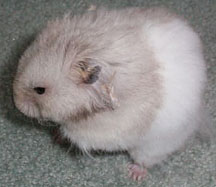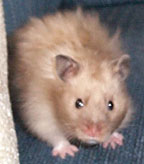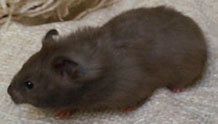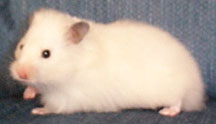
Contents
RRH Index
Extreme Dilute
Syrian Hamsters
Description
History
Genetics
Breeding
Experimental Proofs of
Gene Character and
Transmission
Albinism
ED Photo Gallery
Recessive Dappled
Syrian Hamsters
Description
History
Genetics
Breeding
Experimental Proofs of
Gene Character and
Transmission
Comparison to Other
Patterns
Testing for Allelism with
Dominant Spot
RD Photo Gallery
Working on Type
Syrian Hamster
Genetics
Contact
|
Extreme Dilute Syrian Hamsters
Ultimately, these six hamsters were shown to be (clockwise from the top) Heterozygous Extreme Dilute, Extreme Dilute Sable, Umbrous Heterozygous Extreme Dilute, Heterozygous Extreme Dilute Black, Extreme Dilute Black Eyed Cream and Extreme Dilute Black. Because of the multiple sources, it was believed that Extreme Dilute was already present in significant numbers in the U.S. Midatlantic states. By March 2003, they stretched from Maryland to Maine in the commercial population, and in April 2003 several specimens were shipped by us to AAA Hamsters in California where they will be developed further. Extreme Dilution is a type of partial albinism that is known in mice. It prevents formation of most of the yellow-red pheomelanin pigment, changing what remains to shades of cream. Brown-black eumelanin is slightly diminished. Since the Syrian phenotypes of both homozygotes and heterzygotes matched those in mice almost exactly, and the genetic locus was identical, the name was adopted for use in Syrians. (Complete proofs can be found at Experimental Proofs of Gene Character and Transmission.) The mutation is a C locus gene with the symbol ce and is completely recessive to C. The Extreme Dilute genotype, then, is cece. The gene is codominant to the Dark Eared White allele, cd, producing heterozygous (cecd) phenotypes that are intermediate in color and markings between Extreme Dilute and Dark Eared White. In these, eumelanin becomes grey with a brown tint, and pheomelanin becomes a paler cream. Heterozygous Extreme Dilutes also have a more noticeable red glow to the eyes. Propagation and good development of Extreme Dilute hamsters depends on crossing them into pure Golden lines. The pure Extreme Dilute phenotype is still uncertain in terms of its ideal shading because the original lines were heavily laced with Banded, Umbrous and several color genes. Clouding of the issue by Dark Eared White, present originally and introduced in testing, has been a persistent problem. Of course, the generation of Extreme Dilute combination colors or heterozygous forms requires these other color genes. Evidence to date suggests that conbinations with Black, Black Eyed Cream and Sable are attractive colors with some merit. (See the Extreme Dilute Photo Gallery.) Extreme Dilute Cinnamon and Heterozygous Extreme Dilutes Cinnamon and Black Eyed Cream seem to offer little more than a dirty white hamster. Unless the heterozygous forms of Black or Golden are desired, care should be taken not to breed to a hamster with a Dark Eared White gene. For instances where a breeder is uncertain if a hamster is Extreme Dilute or one of the greys, the definitive cross is to a Dark Eared White. With an Extreme Dilute, the entire litter will be Heterozygous Extreme Dilute or one of its combinations. With a grey, the litter will be all full-colored hamsters unless the grey also carries DEW. The Dark Eared White is also used to differentiate Extreme Dilute from Heterozygous Extreme Dilute. In the former case, the litter will be 100% Heterozygous ED; in the latter, there will be a mix of Heterozygous ED and DEW. Similarly, Dark Eared White can be used to define carriers of the ED allele. |

No part of this website may be reproduced in any form or by any means
without the prior written consent of the owner.
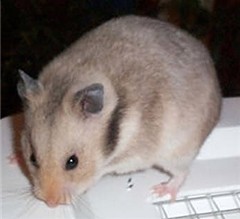 An Extreme Dilute hamster closely resembles one that is both Light Grey and Heterozygous Silver Grey
together. The agouti coat is light grey ticked with black and has a pale grey undercolor. Overall, there are subtle cream tones which intensify on the hindquarters. On the face
the cream tones are stronger, approaching golden near the nose. The ivory belly extends into ivory crescents behind black/dark brown cheekflashes. Ears are grey. Eyes are black, with
those of young hamsters showing a red glow under bright light. Older hamsters darken as more intensive cream tones develop throughout the coat. Extreme Dilute can be combined with any
other color, coat type or pattern.
An Extreme Dilute hamster closely resembles one that is both Light Grey and Heterozygous Silver Grey
together. The agouti coat is light grey ticked with black and has a pale grey undercolor. Overall, there are subtle cream tones which intensify on the hindquarters. On the face
the cream tones are stronger, approaching golden near the nose. The ivory belly extends into ivory crescents behind black/dark brown cheekflashes. Ears are grey. Eyes are black, with
those of young hamsters showing a red glow under bright light. Older hamsters darken as more intensive cream tones develop throughout the coat. Extreme Dilute can be combined with any
other color, coat type or pattern. In December 1999 this longhaired female was found in a Long Island pet store litter of whites. At the time
she was only four weeks old, and with careful scrutiny it could be seen that she wasn't totally white, but had a faint grey tint. Her dam was a Dark Eared White that had been in a tank with male
Dark Eared Whites, Flesh Eared Whites and Creams. All of these males were first or second degree relatives to the female. The line had interbred extensively in the store since the sexes
were not kept reliably separate. This hamster was the only one ever noted to have unexpected and unusual coloring.
In December 1999 this longhaired female was found in a Long Island pet store litter of whites. At the time
she was only four weeks old, and with careful scrutiny it could be seen that she wasn't totally white, but had a faint grey tint. Her dam was a Dark Eared White that had been in a tank with male
Dark Eared Whites, Flesh Eared Whites and Creams. All of these males were first or second degree relatives to the female. The line had interbred extensively in the store since the sexes
were not kept reliably separate. This hamster was the only one ever noted to have unexpected and unusual coloring.
